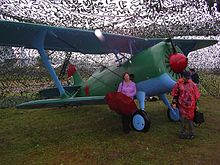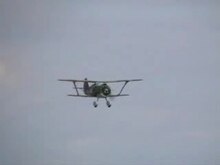Polikarpov I-15
| Polikarpov I-15 | |
|---|---|

|
|
| Type: | Fighter plane |
| Design country: | |
| Manufacturer: |
OKB Polikarpow , |
| First flight: |
October 23, 1933 |
| Commissioning: |
1934 |
| Production time: |
1934-1939 |
| Number of pieces: |
674 (I-15) |
The Polikarpov I-15 ( Russian Поликарпов И-15 ) was a single-seat biplane - fighter aircraft of Soviet production, which first flew in the first half of the 1930s and as late as World War II was used. Because of the distinctive shape of the upper wing, which was not continuous, but bent towards the fuselage, it was nicknamed Chaika (Чайка, seagull). A total of 3082 copies were built of it and the further development I-15bis .
development
I-15
Nikolai Polikarpow designed the I-15 from February 1933 at the ZKB as a successor to the I-5 used since 1930 . The prototype was named ZKB-3 and was powered by an American Wright SGR-1820 / F-3 engine with a Townend ring and an output of 715 hp. As early as October 1933, the month-long flight test began, which was satisfactory and was carried out by Valery Chkalov .
Originally the I-15 should be equipped with an M-22 radial engine. However, since its production was delayed, the first 59 machines were equipped with the Wright Cyclone when series production began in 1934 . The M-22, a Bristol Jupiter built under license , was used from 1934 to 1936 and from 1937 the more powerful M-25, made under license from the Wright R-1820 . There were some differences in production, some I-15s were fitted with a continuous upper wing for no apparent reason. The majority of the aircraft were manufactured in the State Aircraft Plant No. 1 in Moscow, the remaining 2% were produced in Plant No. 39 in Irkutsk.
The I-15 was presented to the public at the international aviation exhibition in Milan in 1935. On November 21 of this year, Vladimir Kokkinaki set a new absolute altitude record for aircraft with a slimmed-down Series I-15 with 14,575 m.
From 1934 404 I-15 with M-22 and 270 with M-25 engine were put into service. During the Spanish Civil War , the USSR delivered 155 aircraft designated as Chato (snub nose) to the Republican government in Spain on October 13, 1936 , which they used against the Heinkel He 51 and Messerschmitt Bf 109 of the German Condor Legion . The first war operation took place on November 4, 1936 in an aerial battle over Alcorcón (Greater Madrid ). The I-15 was easy to fly and very popular with pilots. The time to fly a full circle was only eight seconds.
In Spain, after the end of the civil war, another 237 machines were built under license and used in flight operations until the end of 1955. The main locations were Valencia , Alicante and Valladolid.
When China was invaded by Japan in 1937 , I-15 was also in its portfolio. A total of 674 I-15 machines had been built by the end of 1937. A test model I-15GK equipped with a pressurized cabin in 1937 did not get beyond the test stage, as did an attack aircraft project from 1936. Some I-15s of the 2nd series with M-25 engines were equipped with two 12-7 mm MG BS and used as I-15BS .
I-15bis (I-152)
The further development of the I-15, equipped with an improved M-25W engine, flew for the first time in 1936 under the factory designation ZKB-3bis and reached the troops in 1937. Obvious changes to the predecessor were the wider engine cowling, a larger fuel tank and the continuous N-stem upper wings supported on the fuselage. The structure as a whole was given a new profile shape and had been enlarged by 0.6 m².
I-15bis flew in the Second Sino-Japanese War in 1937, in the Japanese-Soviet border conflict in 1939 and in the Winter War against Finland in 1939/40 . In the Great Patriotic War they were mainly used as fighter-bombers and disappeared from the front-line units by 1942. A total of 2408 I-152s were built.
construction
The I-15 / I-15bis had a welded tubular steel hull with fabric covering, only the bow was covered with duralumin. As was customary at the time, the pilot sat in an open cockpit. The upper parts of the fuselage could be folded down to make it easier to get in and out. The upper wing of the I-15bis was connected to the fuselage by N-braces and to the lower wing by I-braces. The entire structure was braced, the tail unit in normal construction was connected to the underside of the fuselage by V-shaped legs. The main wheels of the landing gear had a streamlined fairing, which in practice was often removed. The rear spur of the machine was sprung.
Versions
- The I-152 series version with, in contrast to the I-15, a more powerful engine and a continuous upper wing.
- A two-seater school version called DIT . It was 180 kilograms heavier than the conventional I-152 and armed with two 7.62 mm MG SchKAS .
- The I-152TK from 1939, equipped with two TK-3 turbo compressors .
- The I-152GK was an experimental prototype with a hermetic cabin from Shcherbakov from the same year . GK stands for "Germeticheskaya kabina". This pressurized cabin, known as the SK-IV "Stratosphere Capsule", was first tested in 1937 by the NII WWS (GLITS), the research institute of the air forces, and installed in at least one I-15. Development of the I-152GK was discontinued because the 68 kg weight gain and the fact that the capsule could not be opened at higher speeds in emergency situations were considered unacceptable.
- The test vehicle I-152DM for two ramjet engines DM-2 from Igor Merkulow. The tests were carried out on a total of 54 flights from December 1939 to June 1940 by Pyotr Loginov. The engines only increased the speed by about 18–22 km / h.
Countries of operation
Technical specifications
| I-15 (1937 series) | I-15bis (I-152) | |
|---|---|---|
| crew | 1 | |
| span | 9.75 m | 10.20 m |
| length | 6.10 m | 6.28 m |
| height | 2.19 m | 2.94 m |
| Wing area | 23.55 m² | 22.53 m² |
| Preparation mass | 1180 kg | 1310 kg |
| Takeoff mass | 1730 kg | |
| drive | an air-cooled 9-cylinder radial engine Schwezow M-25 | an air-cooled 9-cylinder radial engine Schwezow M-25B |
| power | 715 hp (526 kW) | 750 PS (552 kW) |
| Top speed |
315 km / h near the ground 376 km / h at an altitude of 3000 m |
316 km / h near the ground 346 km / h at 5000 m altitude |
| Rise time | 3.3 min at 3000 m altitude | 6.7 min at 5000 m altitude |
| Summit height | 9000 m | 9500 m |
| Flight duration | 2.6 h | |
| Range | 725 km | 770 km |
| Duration of a full curve | 8-8.5 s | 10.5 s |
| Armament | four 7.62mm MG PW-1 200kg bombs |
four 7.62 mm MG PW-1 or 12.7 mm MG BS in later versions SchKAS instead of PW-1 150 kg bombs or six RS-82 missiles |
See also
literature
- Jefim Gordon , A. Dexter: Polikarpov Biplane Fighters , in Wings of Fame, Vol. 17, 1999, pp. 106-129. (English)
- Michael Sharpe: Biplane, Triple Decker & Seaplanes , Gondrom, Bindlach 2001.
- Olaf Groehler : History of the Air War 1910 to 1980 , Military Publishing House of the German Democratic Republic, Berlin 1981.
- Wilfried Copenhagen : Soviet fighters , transpress, Berlin, 1985, VLN 162-925 / 145/85.
Web links
- Polikarpow I-15/152/153 ( with photo of the record-breaking aircraft from 1935 )
Individual evidence
- ^ Rainer Göpfert: Polikarpow I-15 / I-15bis. In: Fliegerrevue No. 11/2014, p. 52.
- ^ Wilfried Copenhagen: Soviet fighter planes . Transpress. Berlin, 1985. p. 109.
- ↑ Ulf Gerber: The great book of Soviet aviation 1920–1990. Rockstuhl, Bad Langensalza 2019, ISBN 978-3-95966-403-5 , pp. 605 and 612
- ↑ Jefim Gordon, A. Dexter: Polikarpov Biplane Fighters , in Wings of Fame, Vol. 17, 1999, photos on p. 120.
- ↑ Jefim Gordon, A. Dexter: Polikarpov Biplane Fighters , in Wings of Fame, Vol. 17, 1999, p. 123.
- ↑ Manfred Jurleit: Flying stove pipes. In: Fliegerrevue No. 3/1973, p. 131.


